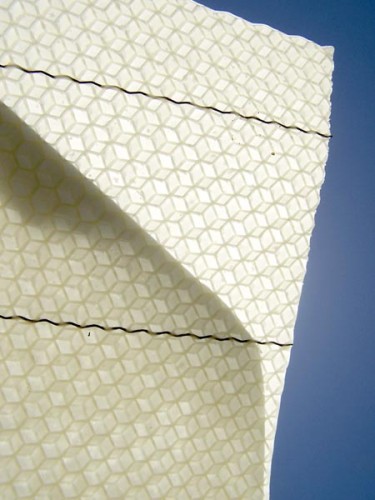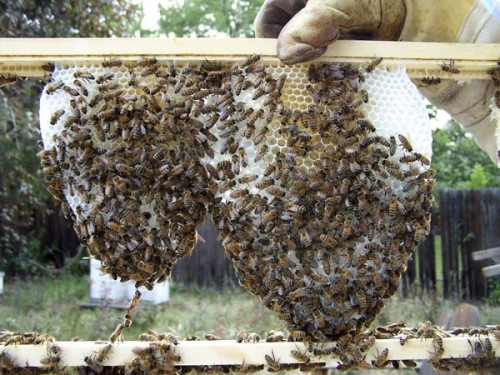Beeswax and breasts: Do you know what’s in yours?
Molecules get into our bodies through a number of different paths: through food, through water, through just touching substances, and also we breathe them in. It turns out our breasts are almost like sponges the way they can soak up some of these chemicals especially the ones that are fat-loving.
– Florence Williams, author of Breasts
Flame retardants, pesticides, jet fuel particles – these are a few of the compounds science reporter Florence Williams found in her breast milk while doing the research for her book, Breasts. I caught a snippet of Williams’ interview with Terry Gross on NPR’s Fresh Air and was struck by how closely the Breasts story tracks with beeswax. Beeswax, like breast tissue, is a fatty material with a spongelike capacity to absorb nearby chemistry. Bee researchers have identified over one-hundred pesticides and metabolites in bee comb samples. They are catalogued in the paper, “Pesticides and honey bee toxicity.” (Link below.)
What have researchers found in beeswax?
A mix of fungicides, herbicides, miticides, insect growth regulators and pesticides including neonicotinoids and organophosphates.
How do pesticides get into beeswax?
• Beekeepers introduce them when they use synthetic miticides to control varroa mites. These fat-loving or lipophilic compounds “may remain in the wax components for years following treatment.”
• Honeybees introduce pesticides to their colonies when they bring loads of contaminated pollen and nectar back home for processing, consumption and storage in wax comb cells.
• Beekeepers add to the load when they use comb foundation manufactured from processed wax in their hives. “All foundation beeswax pressed into sheets and used as templates for comb construction sampled from North America is uniformly contaminated ….”

This crimped beeswax foundation smells wonderful but is "uniformly contaminated" according to bee researchers. © Laura Tyler
While all the contamination methods listed above concern me as a beekeeper, it’s the uniform contamination of wax foundation that most concerns me as an artist. If all beeswax foundation is “uniformly contaminated” then it means all beeswax processed in the same way – gathered from multiple sources, melted and filtered – is similarly contaminated.
I work with wax. What can I do to minimize my exposure?
• Ventilate.
• Wear protective gloves. It’s been my habit to wear latex gloves only when handling messy paintings and pigment sticks but not when handling encaustic medium. I am reevaluating.
Can’t I just buy organic wax?
Short answer: No. The USDA doesn’t certify bee products. As of today there’s no such thing as federally certified organic beeswax in the United States. Longer answer: It’s complicated. If you’d like to know more about organic beeswax and the methods and terminology U.S. beekeepers are using to work around it, let me know in the comments.
What about pharmaceutical grade beeswax?
Again: It’s complicated. Pharmaceutical grade doesn’t necessarily mean pesticide free. Some pharmaceutical grade waxes are highly filtered. Others, less so. Regardless of the type and grade of wax you’re using, the safety advice remains the same. Ventilate. If you’re not ventilating, think of the information here as a reason to re-think your practices. If your ventilation is good, excellent! Let’s talk about gloves.
Artists, do you use gloves when you handle beeswax in your studio? Why or why not?
LINKS
Just What’s Inside Those Breasts?
Pesticides and honey bee toxicity
Venting Your Studio for Encaustic

Excellent info, Laura. I’ll share this link. Thanks!
Great info Laura. I started wearing gloves to paint in 1983 and have ever since! I use them for oils, encaustic and anything messy. As for ventilation – I’m never convinced it is enough indoors – I prefer working outside.
Thanks for sharing, Hylla. And thanks, Christy, for modeling safe practices. Like seat belts of yore, gloves feel weird ’til they’re a habit and then you feel naked without them.
I would like to know what the requirements are to claim beeswax as pharmaceutical grade…there doesn’t seem to be a copy of the US Pharmacopeia and Nat’l Formulary online (that is accessible to non-students). Do you know where this information can be found?
found it, thanks just the same…anyone wbo wants to dive in can start at USP/NF or google NF Monograph for Yellow Wax.
Thank for the question and update, Monte. I’ve requested a hard copy of the USP-NF via my local library and expect it to arrive in 3 – 5 days. To my knowledge pharmaceutical grade beeswax is not tested for any of the contaminants mentioned above. I’ll let you know if I find out otherwise.
I just came across this, thought it might be of interest. I have been reading your blog and researching “natural” waxes, bee in particular. How did things get so complicated?
http://www.brenntagspecialties.com/en/downloads/Products/Personal_care/Koster_Keunen/Pharmaceutical_Waxes_Flyer.pdf